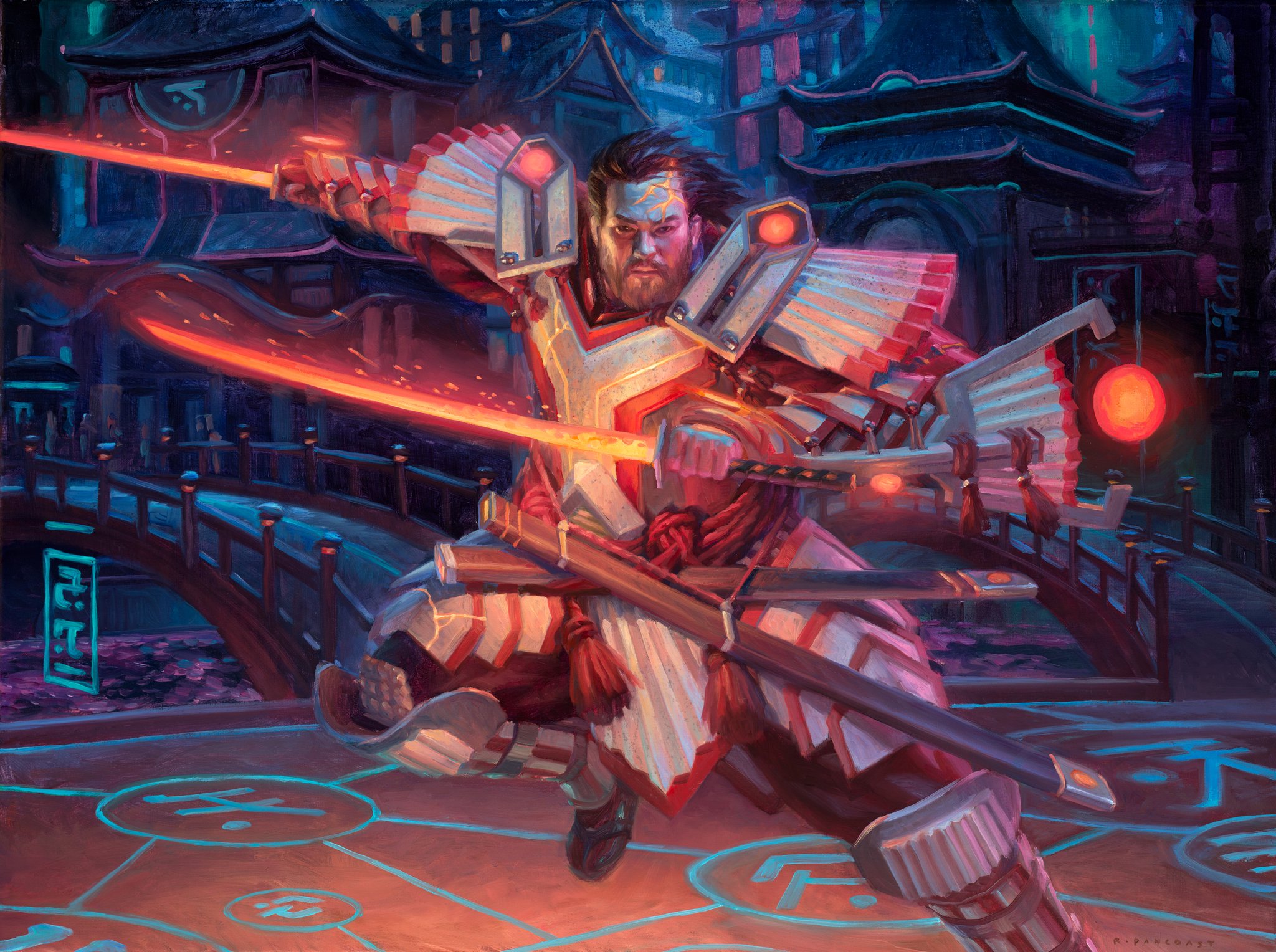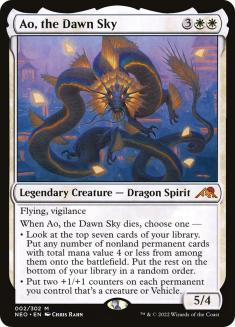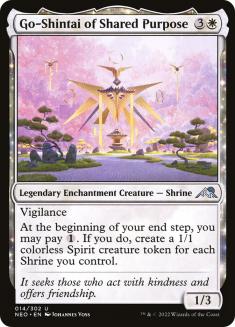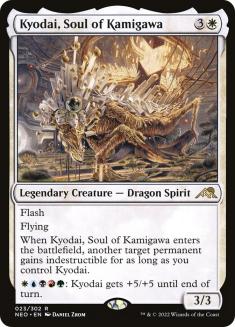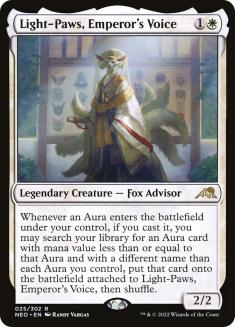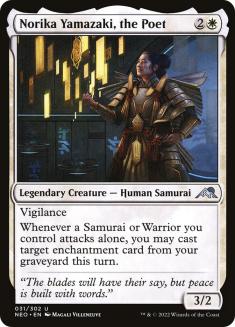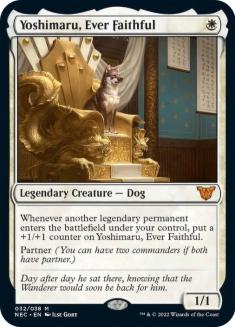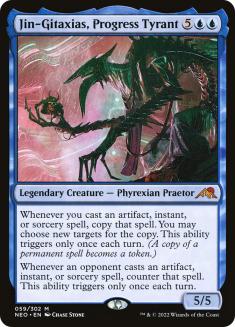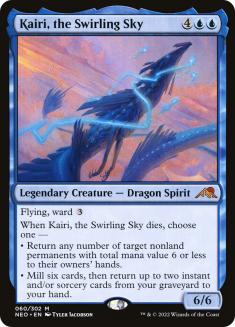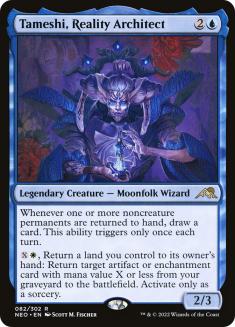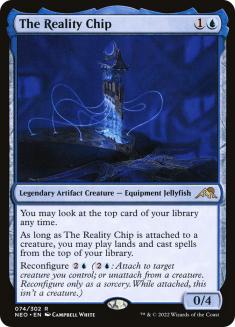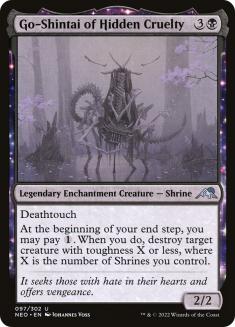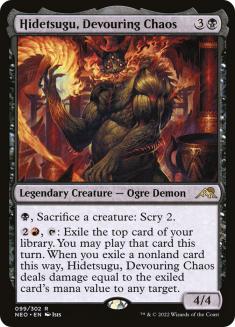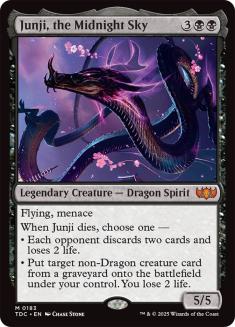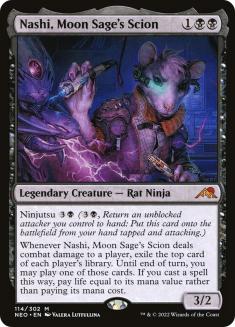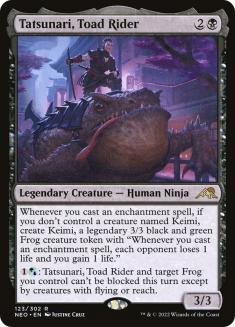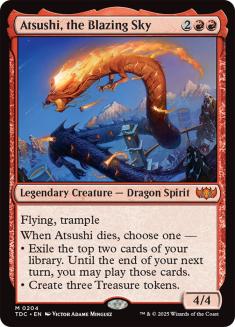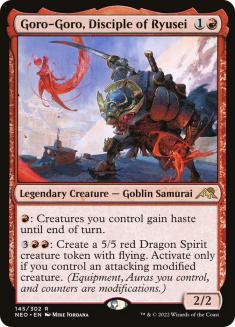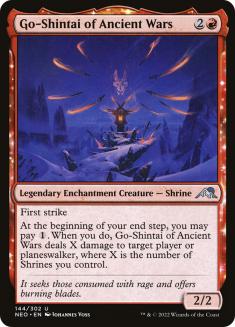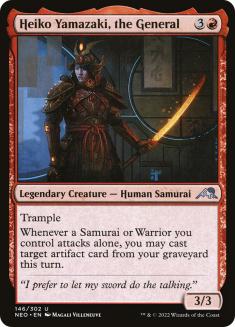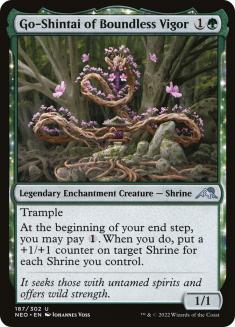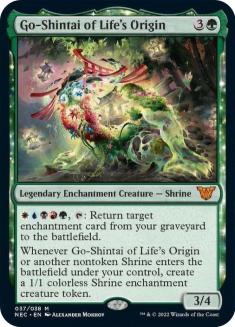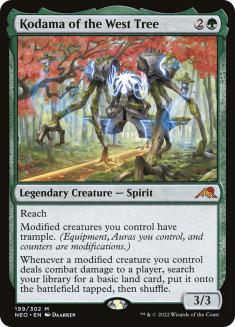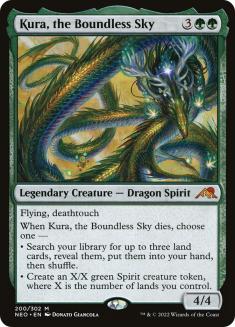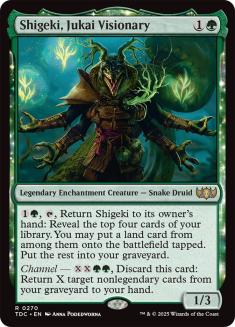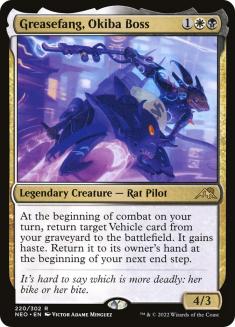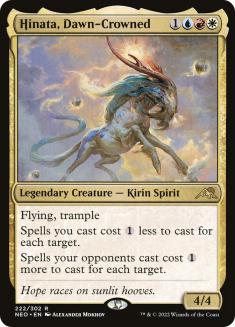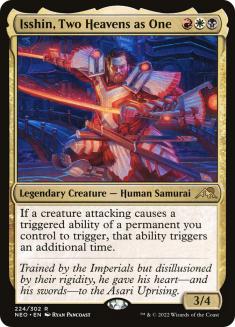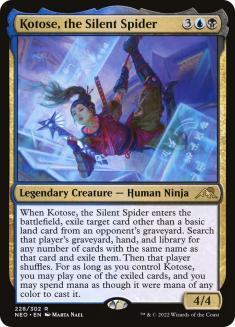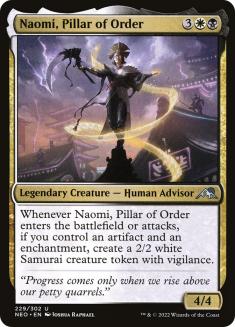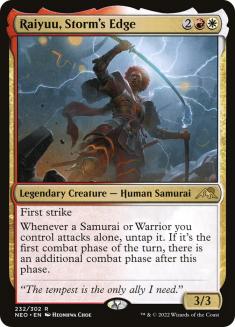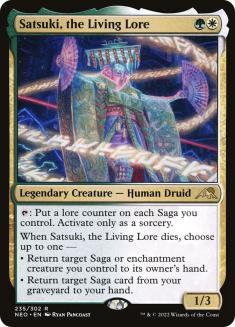The Kamigawa: Neon Dynasty previews so far have revealed a Vorthos-laden set filled with references to some favorite cards from the original Kamigawa block — and more. Don’t look now, but there’s even a Praetor.
For Commander, the cards we want to most look at are the legendary creatures, our new potential commanders. What we’ve seen up to now are mostly monocolored legendary creatures, so it might be time to start exploring deck builds of a single color. I’ll talk this time about those legendary creatures, looking at them both from the angle of leading a deck and fitting somewhere into the 99. We’ll sort them by color for easy reference. I’ll mostly be looking at these cards from the perspective of someone playing at the middle power levels of Commander, although if any of them have high-power implications, I’ll mention it.
White
The Commander Rules Committee (RC) changing the way dies triggers work with commanders has opened some good design space for our friends in Studio X. Ao, the Dawn Sky shows them walking through that door. With two compelling choices for a dies trigger, Ao the Dawn Sky is an excellent choice to both lead a deck and go into another one.
The first trigger is the thought-provoking one; the second seems simply strong. The first is the one that I’d love to play around with a bit. It’s like a mini Protean Hulk-meets-Reveillark. Whether or not Ao is leading the deck, you’ll want a tight curve, with low-mana-value permanents that take advantage of being able to look at seven cards and put two or three of them onto the battlefield. Ao will pair nicely in a deck with Sun Titan in case the permanents you put out get destroyed.
The second trigger is just all about beefing up your team. It suggests a Mono-White Aggro deck and gets you moving early. Ao is a 5/4 flyer with vigilance for just five, so it can start laying the beats itself. The fact that you can put the counters on Vehicles means that you can build some protection from battlefield sweepers into the deck. The previews have revealed only a few, like the delicious Mechtitan Core, but that seems like a promise of more.
First things first: Shrines are back. Although Go-Shintai of Shared Purpose is an enchantment creature, Shrine is an enchantment subtype, so you can’t name it with Arcane Adaptation to go Shrine ham. Still, this nice little uncommon can serve as both a commander and a Shrine deck insert. The main power of Go-Shintai is that you don’t have to wait for your upkeep to get the Spirit(s). You’ll need that extra mana to pay for the trigger, effectively costing you five mana the first time through. Once you’re on the Shrine plan, though, that one mana will seem cheap when you’re busting out several tokens. I worry about Go-Shintai’s vulnerability, since it’s a creature, but there are plenty of ways to get it back.
Someone in Studio X seems to have not gotten the message on making WUBRG commanders actually have WUBRG in the mana cost. Still, Kyodai is hardly as strong as Kenrith, the Returned King or Sisay, Weatherlight Captain. A 3/3 flyer for four is a reasonable rate, but the strength of Kyodai is in giving another creature indestructible. Pair it with Deathless Angel or one of the other white cards that grants indestructible to keep Kyodai and what it’s protecting around. Kyodai can certainly go into commander damage mode, needing only three buffs to become lethal. I see it more of a choice as a commander than slotting into a five-color deck.
If you want to go full ham on Auras, you’ll need to get into this Fox’s den. Light Paws will keep the Auras flowing as you cast them. The “different name” restriction isn’t a problem for Commander. Your trick with Light-Paws as a commander will be to find all the mono-white Auras that you want. While the one you cast to trigger the ability doesn’t have to go on Light-Paws, the resolving ones do. Voltron lines are the obvious ones for Light-Paws as commander. As a player in Enchantress decks, Light-Paws will offer you a secondary victory path, smashing some pretty good face.
Part of the “Samurai or Warrior attacking alone” team, Norika works on getting back some enchantments that you’ve lost. I like it with things like Seal of Cleansing that you sacrifice to get effects from or enchantments that draw a card when they enter the battlefield. The underplayed Lashknife Barrier is a good fit here.
There are plenty of white Warriors for Norika to lead a deck with. There are also a surprising numbers of Samurai (23, in fact, not counting what’s in Kamigawa: Neon Dynasty). That said, Norika looks more like a utilitarian card in a deck that has some Warriors in it. She might even be able to sneak into a Boros deck that also has Godo in it. Although I’ve been clear that I think partner is a dangerous mechanic, I would have been okay with Norika getting partnered with Heiko Yamazaki. Partner with is inherently safer, for sure.
I’m not wild about introducing more partners into the mix, but this legendary Dog seems like they’ll be good. Maybe partnered with Rograkh, Son of Rohgahh for some pretty serious action at the high-powered end. You can cast both Turn 1 and that’s before any other shenanigans. On the lower-powered side, it’s a clear slot into your Rin and Seri, Inseparable deck.
Blue
You definitely get what you paid for when you resolve this scary Praetor. Copying a spell for zero mana is very strong. I’m happy that they gated the power to trigger only once per turn, though. Otherwise, this Jin-Gitaxias version might be broken.
Countering opponents’ spells is also quite something, although again they’ve made it not so oppressive. Opponents will be able to play around it by first casting the cheap thing they don’t really want so that they can then get to the spell they need to resolve. The good news for you is that if it’s on your turn, they’ll have a tougher time, since they’re limited to only instants.
Jin-Gitaxias doesn’t seem like much of a build-around for mono-blue. Sure, the value is great when you double up on draw spells like Mystic Confluence, but that’s not really a theme. Since I mentioned Mystic Confluence, when you copy the spell, the copy’s modes are the same as the original’s. You simply get to choose new targets for the existing modes if you like.
I’ll likely be playing Jin-Gitaxias in my Dreaming of Intet deck, which likes to cast big X-spells. Copying a Comet Storm for free will do some outright killing.
Kairi, the Swirling Sky is another in the death-trigger cycle of legendary creatures. The two modes don’t seem to have too much to do with each other, so you can decide which is better for your battlefield state. The first thing to notice about the first ability is that it can sweep the battlefield of all the (non-copy) tokens that everyone has created—to include the ubiquitous Treasures running around the format. Avenger of Zendikar’s Plant tokens will also be victims of Kairi’s angry death.
I like the idea of using Kairi’s second trigger in a deck that also has Jin-Gitaxias, Progress Tyrant. That way, you can get back two spicy spells to cast and copy again. Once again, as I think we’ll see as a trend with the mono-colored legendary creatures in this set, they look like excellent role-players in other decks instead of leading them.
My final comment on Kairi is that the ward 3 ability seems just stapled on. A flying 6/6 for six with your choice of two strong abilities is already pretty good. Adding ward pushes the card unnecessarily, especially in the best color for protecting your own permanents.
The first thing that comes to mind with Tameshi, Reality Architect is looping Tormod’s Crypt, Scrabbling Claws, or your cheap artifact of choice. I fixated a bit on the fact that I couldn’t return creatures for value, but bouncing lands is okay. Trade Routes pairs very nicely with Tameshi since you can do it on other players’ turns as well, thereby getting around the triggering only once per turn restriction. And don’t tell anyone I mentioned Glacial Chasm with Trade Routes.
Like with Norika Yamazaki, you can also focus on enchantments that sacrifice for effects and/or have good enters-the-battlefield triggers. Cumulative upkeep is another direction to consider. I always wanted to make something out of Glacial Plating. Turning Tameshi into a stone killer seems like a fun route to go.
When The Reality Chip was previewed, Commander Advisory Group (CAG) member and friend of the show Jim Lapage said, “They can stop revealing cards. This is my favourite card in the set. I don’t care what else gets previewed.” It was difficult to disagree. Who can’t love a legendary Jellyfish Equipment?
We get to see in The Reality Chip our first glimpse of the reconfigure mechanic, which turns a creature into an Equipment for as long as it’s attached. This is a cool mechanic because, once attached, it preserves a creature for after a battlefield sweeper.
The Reality Chip is a better Future Sight with slightly less blue mana involvement. You can look at the card instead of it being face-up. You can only cast that card when The Reality Chip is attached to something. That’s the price to pay for keeping the hidden zone hidden. All in all, I’d like the card even if it weren’t a legendary Jellyfish.
Black
You’ll definitely need the help of other Shrines to make this one work. Knocking off 1/1s isn’t going to do all that much for you. This one is pretty straightforward and not particularly compelling unless you’re really in big Shrine territory.
A throwback to Heartless Hidetsugu, Hidetsugu, Devouring Chaos can also be pretty heartless. The creature sacrifice to scry is in line with what we can expect from a black creature. Costing mana to do so is a modern-era development that I suspect we’ll continue to see instead of the kind-of-broken free ones like Nantuko Husk, Goblin Bombardment, and Altar of Dementia, just to name a few.
The power comes to Hidetsugu, Devouring Chaos in its second ability. Not only do you get to bottle a card, Hidetsugu deals damage when you exile it. Importantly, you can do it to any target. Nicely for you, the ability creates a trigger; you don’t have to choose the target until you know what the card is. No more going blind into seeing if you’ll do enough damage to said target. Hidetsugu’s ability to exile cards makes it a nice fit into Prosper, Tome-Bound decks.
The next in our Dying Dragons series, Junji, the Midnight Sky thrives on dying. In Commander, there aren’t too many situations in which you can use the second ability that you’ll use the first. It’s a great response to a battlefield sweeper. If someone casts Wrath of God, you’re going to get the best thing from your graveyard back onto the battlefield—although it unfortunately can’t be Junji itself.
Junji seems like a strong role-player in a self-mill deck like Old Stickfingers. It’s one of the creatures you want to cast instead of having in the graveyard, at least initially. If you can loop it via Oversold Cemetery and whatnot, so much the better. As a commander, Junji will get expensive to keep casting again. Of course, being in black you might just keep it in the graveyard for all those reanimation tricks you have. The card doesn’t suggest much as a build-around commander.
Ninja Rats! In the tradition of Ink-Eyes, Servant of Oni, Nashi, Moon Sage’s Scion lets you get spells from the top of opponents’ libraries instead of the graveyard. It’ll cost you some life, but you’ll be exiling the things you don’t cast. What’s nice is that you can hit anyone to get the trigger. You know there’s going to be something sweet on top at least one of those libraries. I don’t see Nashi as commander, but as a player in another Ninja or Rat deck.
One of the reasons people are so hyped for this set is no doubt the fun they’re having with creature types and names. People love Frogs, so it’s a natural. Because its color identity is Sultai by virtue of the hybrid mana symbol in the activated ability, you might be able to have it lead a deck that at least has a Frog tribal subtheme. You have tools like Arcane Adaptation to turn everything you have into Frogs.
The activated ability takes on the flavor of the Frog leaping into combat, which is amusing. The triggered ability leads you to a Sultai Enchantress deck that gives you Frogs for value. You still get the card draw of Argothian Enchantress and Verduran Enchantress, then get to move into darker territory with black replacing white. Shrines are a way to go, as are Curses. Curse of Unbinding is expensive but saucy, as is Curse of Misfortunes.
Red
This one seems the most bland of the Dragon cycle. I don’t see a build-around, instead wanting to just jam it into a Dragon deck and grab some value. Its best play line is for some kind of sacrifice-for-infinite-mana loop with Phyrexian Altar, a way to get it from your graveyard to your hand (Enduring Renewal, maybe?), then Dragonspeaker Shaman to make it less to cast. I suppose that’s the build-around, but you’d need it as the secret commander, since you can’t have Enduring Renewal in mono-red. It could certainly be an element in a Hofri Ghostforge deck.
Goro-Goro as a new Goblin commander? Probably not, but that ability to give all your creatures haste is spicy. Attacks out of nowhere can end commander games, although you can’t get one with Goro-Goro’s activated ability. You have to be already attacking (with a modified creature) to get the Dragon Spirit, so you won’t have a window to declare it as an attacker. The build line is obviously for modified creatures, but since that comes in three different flavors, you have lots of room. I’d try to find some neat Equipment. I like the image of Goblins carrying badass swords. Just make sure you don’t pick one that gives protection from red, or you won’t be able to target the creature with the haste ability.
These Shrines still need each other, especially when you’re paying for them. Nothing special here, although I guess it’s nice that you can battle with it.
Like Heiko’s sister, I’d want to focus on things that sacrifice for value and then are cheap to recast. Mycosynth Wellspring offers up some help for decks that don’t ramp well. Wayfarer’s Bauble is even better. Artifact creatures count, so go ahead and jam that Solemn Simulacrum again. If you build around Heiko’s ability, you’ll also want to make sure that she doesn’t get killed in combat, so a nice Boldwyr Intimidator or Rogue’s Passage will go a long way.
Green
Go-Shintai of Boundless Vigor is one of the Shrines that’s okay-ish by itself. It just grows bigger every end step if you have the one mana. Spreading those counters out to other Shrines will be fine, especially since they’re also giving back. It doesn’t change my mind that the Shrines are a neat idea to explore without being overpowered in play.
Instead of shaking my fist at the designers in Studio X for making a five-color commander that doesn’t cost WUBRG to cast, I’ll congratulate them on making Shrine tribal possible. The question is what you’re going to do with all those Shrine tokens. They’re creatures, so it’s not going to get completely out of hand—or is it?
In green, the way to go with Kodama of the West Tree is with cards that have +1/+1 counters on them. Use a little graft from Cytoplast Rootkin or Llanowar Reborn to get Kodama of the West Tree ramping you up. Spike Feeder and Spike Weaver can move around counters or just attack on their own. The more creatures you get into this party, the better. Sword of the Animist is a fine idea since you get a land on the attack trigger and then when you connect. Whispersilk Cloak will ensure that Kodama of the West Tree gets through and that you get your land for it being modified.
While leading a mono-green deck, don’t sleep on Kodama of the West Tree as a player in an Aura-based Enchantress deck. I’d also consider it pretty strongly for a Rosheen Meanderer deck that does Hydra tribal. Remember that the trigger is for each modified creature, so Kodama of the West Tree doesn’t itself have to attack.
Flying and deathtouch in a five-mana 4/4 is already where we’d expect this Dragon in the cycle to be. The first death trigger seems mediocre until you realize that it’s three of any land cards. You’re free to go grab Cabal Coffers and Urborg, Tomb of Yawgmoth or whatever your favorite combination of lands might be. The second trigger is also very spicy, because you know you’ll have a reasonable number of lands on the battlefield whenever Kura happens to die. As a part of a reanimator deck, like Muldrotha, the Gravetide or Old Stickfingers, Kura is an excellent choice. I like it as more of a role-player than a leader. If you want to take it down the road of being the commander, lands matter is going to be the deck you want, probably with Boduka Gardener as the secret commander.
Speaking of role-players in reanimator decks—and other self-mill or dredge pieces—Shigeki will keep on giving value. You’re thinning your deck, making sure you hit land drops (which pays for half of the next turn’s activation), and putting stuff into the graveyard. It’s a sweet choice all around. The channel ability is a little expensive, although in a late-game pinch, just three mana will get that single, critical card from the graveyard back into your hand. Shigeki is another legendary creature in this set that I find better for the 99 than in the command zone. Its ability will lead you to having lots in your graveyard, and green by itself isn’t the best at doing something about it.
Multicolored
This is some spice. The Vehicle still has to be crewed, but there Greasefang sits, with four power worth of crew action. What I like about the design is that it obviously pushes you into a Vehicle direction, it doesn’t proscribe how you have to pursue the Vehicles deck. It leaves things open so that you can run your favorites from the past or saucy new ones like Reckoner Bankbuster.
Clearly a commander instead of one of the 99, I’d build Greasefang starting with Endrek Sahr, Master Breeder to have other creatures to crew with and Daredevil Dragster in order to draw cards. With Greasefang bringing the Dragster back every turn, your engines will be revving high.
Anything that looks even vaguely Grand Arbiter Augustin IV-like will get my attention. Hinata seems like it’s going to hit the right area. It doesn’t make all opponents’ spells cost more, just the targeted ones. It challenges the assumptions that players come in with, especially when it comes to free spells like Force of Will or Deflecting Swat. It’ll even make people think twice about how they approach Swords to Plowshares or Path to Exile.
On the flip side, making your own targeted spells (which includes Auras, by the way) cheaper is strong while not being a runaway. My first thought is to mitigate the cost of spells that have strive, like Call the Coppercoats or Phalanx Formation. Or supercharging Distorting Wake. You’ll have lots of choices in which to take a deck led by Hinata, who can be an offensive weapon in its own right. A 4/4 flying trampler before it’s ever modified, it’ll get lethal once you start buffing it up.
Whoa, now we’re really talking! Isshin is a Samurai, so we’ll want to explore all those great Samurai-attacking-alone triggers. He doesn’t even need to attack to make his own trigger happen. Isshin is clearly meant to lead a combat-centric deck, which will focus on the red and white elements of its Mardu color identity, then sprinkle in some black for creature control. We can go right to generating extra combat steps, getting outside the Samurai, with Aurelia, the Warleader.
That’s not all that Isshin brings. Note that it triggers on anyone’s attacks triggering your stuff, so get in there with Powerstone Minefield and Lightmine Field. Use the black for Revenge of Ravens or Marchesa’s Decree. Jam Sarkhan the Masterless and Slumbering Dragon. Even an old classic like Caltrops might have legs. Double up on your lifegain with Patron of the Kitsune. Get out your calculator to total up Shared Animosity. We’re also playing Lithoform Engine and Strionic Resonator as well, right? This one’s going to be so much sick fun. Also not for nothing: in Inkshield colors.
Well, we seem to have hit one that’s not worth much in Commander. Because we’re a singleton format, Kotose’s ability will exile a card, and then the search won’t find anything. Playing it in your Ninja deck will provide some small value, but not the kind that you’ve come to expect in a five-mana package. The good news is that not every card has to be good in the format. Others can get some love, too.
Now we have something to build around that doesn’t point us in a single direction. There are lots of artifact and enchantment pairs for Naomi to love on. Orzhov clearly needs some mana rocks to get its game going, so there’s the obvious start. Her trigger is on attacking, so we can go back to the Whispersilk Cloak idea or run out your favorite Sword combination.
As far as enchantments go, Athreos, God of Passage or Erebos, God of the Dead will give you one that sticks around. I like the whole enchantment creature line, with Archetype of Finality, Doomwake Giant, and Nighthowler leading the way. Phyrexian Arena is such a value card that only eats removal when people have lots of it, like Aura Shards.
Once you get Naomi going, you’ll want to go wide with all those Samurai, so plopping down a Coat of Arms will get you into dealing lethal damage in short order. You might worry about the crack back since Coat of Arms applies to everyone; I’ll just point out that you’re in Inkshield territory.
Extra combat steps will win games for you, no lie. I’d want to do that without going in for the obvious. Maybe we could borrow some tech from Dan Sheehan’s discovery that there are more Shapeshifters outside of blue than we think. I think I might choose exalted as my mechanic of choice. Sublime Archangel will power things up just fine, and we don’t need so many creatures to make our lone attacker huge. Unlike Godo, Bandit Warlord, Raiyuu is a Samurai, so she’ll trigger herself. Since you’re in white, you can also run Ardenn, Intrepid Archaeologist, who will get some stuff attached to Raiyuu in short order, then swing for the fences.
I already gushed about this card when the first previews came out. The excitement hasn’t died down. Unless I see something just insane from the rest of the previews, Satoru will be the first post-Kamigawa: Neon Dynasty deck that I build. I’ll have to give it my own kind of flair. I don’t really think Blightsteel Colossus or Jin-Gitaxias, Core Augur is the kind of experience I want to foist on others, although putting huge monsters onto the battlefield on the cheap is right up my alley. Frog tribal is out. Maybe Pirates, since that’s a tribe that gets done in a certain way these days. I’ll plant it in the back of my head and see what the idea farm grows.
I thought I’d love Satsuki, but I’m honestly not sold. It’s clearly meant to run you up through the chapters of new transforming DFC Sagas. Boseiju Reaches Skyward is clearly an exciting one. There’s an enchantment path with Michiko’s Reign of Truth. I’d like to see a few more of the new cards to make a judgment on the Saga angle.
The legendary creatures of Kamigawa: Neon Dynasty offer Commander players some compelling avenues for deck brewing, building, and exploration. Due to their primarily mono-color nature, we see more of them as support cards for other decks while still featuring a few that will turn out as excellent choices to lead them. As we dive deeper into the set, we’ll see the support cards that we’ll want to include alongside the potential commanders and make your plans come to fruition. I look forward to talking about them.

